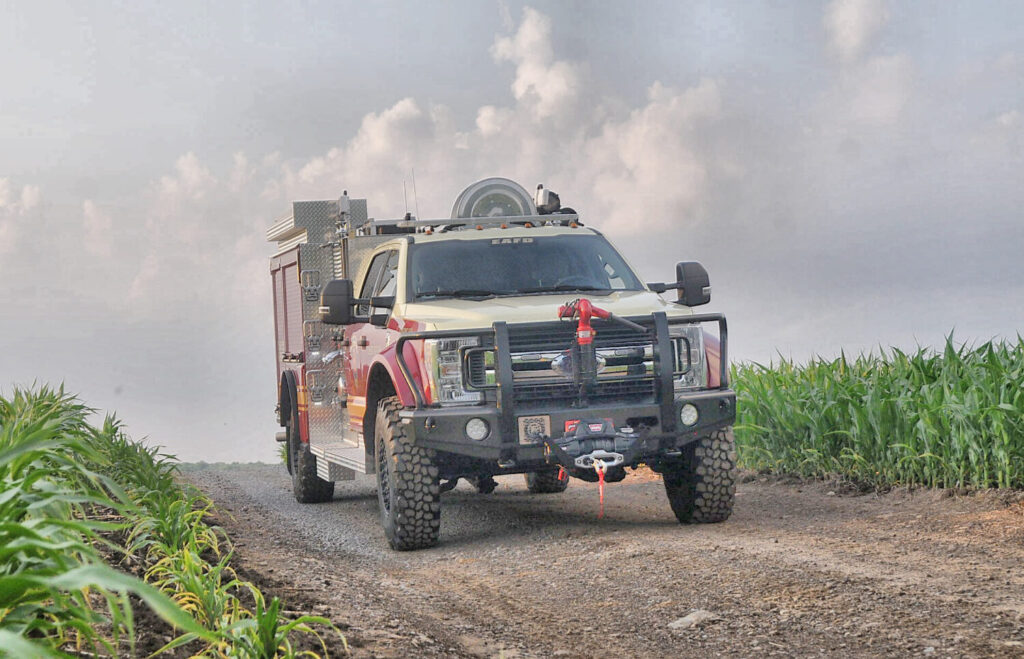
Thousands of fire apparatus accidents occur every year due to neglect towards and errors in tire maintenance, yet checking your tires is a critical element of fire apparatus care that can easily save lives. At FDSOA’s Virtual Fire Apparatus Trade Show, TJ Tennent, the president of Tennet and Associates and The Tyre Guy, gave a crash course on all things tires and wheels in effort to arm those listening with processes and tools required to ensure safe and accurate tire upkeep.
Before diving into the technicalities, TJ mentioned that a must-have tool is the Tire and Rim Association (TRA)’s Year Book since it was written by engineers and outlines all the industry’s standardized information needed to maintain tire usability, such as how much air pressure ratings and rim load capacities. It is necessary to understand that TRA’s standards show a range of options; if you’re ever unsure of what to do next, reach out to TJ for no charge! To buy a copy, head to www.ustra.org.
The first step in ensuring tire safety, of course, is choosing the correct tire for your vehicle. To find out the vehicle’s characteristics needed to determine the correct tire, utilize the Door Placard (on the door of the vehicle) that lists the gross front and rear weight, cold tire pressure and tire rim size. When referring to a commercial truck, it is key to understand the load range (which correlates to maximum load carrying capacity at max pressure), the rim size and inflation pressure. Once you’ve read the Door Placard, refer to the TRA Year Book’s standards to find the tire that fits the vehicle’s qualities. TJ highly recommended to stay within the placard’s range because, “when you do something different it is only a matter of time before the tires fail.” Under no circumstances should you put on a smaller tire than the vehicle is meant for – even when more cost effective – because if there is an accident you can be held responsible. If you desire to put a larger tire on than is meant for the vehicle, you must add the extra steps of changing the calibers, the roaders and much more; it can be done, but still is not recommended.
Reading the size nomenclature of tires can be confusing, so TJ broke “P225/60R16” down as an example: “P” stands for “passenger vehicle” (if “LT” was in place of “P,” it would mean “light truck”; “ST” means “special trailer” and “T” stands for “temporary”); “225” is the “cross section”; “60” is the “aspect ratio,” or the section height divided by section width (of sidewall to sidewall when the tire is mounted on the wheel and inflated); “R” stands for “radial”; and “16” is the rim’s diameter in inches. If there is no “P” (or “LT”, etc.), the vehicle then follows Euro-metric Standards (ETRTO) which would look like: 225/60R16; if the nomenclature has a “C” at the end, it is a commercial vehicle. It’s important to note that there are two types of tires: passenger vehicles have bias ply tires which have two plies and look criss-cross while commercial tires are called radial ply which have four belts with plies going around and up. The biggest difference between the two is the weight it can carry, providing another reason why TRA’s Year Book comes in handy.
Knowing the components of a tire will help with not only choosing the correct tire for your vehicle but also with repairs. Starting from the inside, the innerliner is a rubber compound bound to the inside of the cord body that retains air under pressure. The bead bundle holds the tire onto the wheel while the hard bead filler is a rubber compound used to provide stability to the lower sidewall and bead area; the soft bead filler creates a comfortable ride. The bead area in a commercial truck includes a chafer and bead bundle. The cord body provides tire strength and transmits cornering forces from the tread to the wheel; usually it is made out of nylon, polyester or rayon yet for commercial trucks it is always made out of steel. The sidewall is the area from bead to tread that forms a protective covering for the cord body to resist aging, cracking, cutting and snagging. On a passenger vehicle, there is writing on the sidewall that outlines the tire capacity which should always meet or exceed the Door Placard; think of the sidewall as the skin of the tire that tells you everything you need to know about it. The steel belt plies provide stability to the tread area to improve mileage, impact resistance and traction; commercial trucks have four while other vehicles have two. The most well-known component of the tire is the tread, or the portion of the tire that is in contact with the road surface. The tread’s compound and shape are designed for optimized wear traction, handling fuel economy and cutting resistance characteristics.
When handling a tire repair, be sure to first check out the Rubber Manufacturers Association (RMA) and the Tire Industry Association (TIA)’s resources to better understand what is needed for the repair; you can also contact your vendor’s service center. TJ sees repairs done incorrectly all the time since many do not conduct the proper procedures. It is necessary to repair using a patch-plug combination rather than a patch only because when the plug is not installed, the injury is left open which allows moisture to get inside the steel and cause even more damage in the long run. Commercial tire repair requires a special type of patch in the sidewall, so always do your homework before diving in.
If applying a new tire altogether, be sure to replace the rear axle to maximize safety, particularly when in wet conditions as the vehicle can easily spin out of control. Interestingly enough, there is no law that states when to replace a vehicle’s tires, yet the standard is to remove and inspect the tires after 6 years from its application date and every year from then on until you hit ten years when they need to be replaced. Never use a tire that is more than ten years old! However, the standard for a fire apparatus is changing the tires every seven years, no matter what. Goodyear takes the lead in compound tires, which are recommended for fire apparatuses, but always try to speak with an engineer or tech representative (rather than a salesperson) to better understand the mechanics and ensure you are getting the biggest bang for your buck.
The best way to avoid having to replace tires is by checking the air pressure every month, including the spare tire. Tires lose about 1 psi for every ten degrees dropped in the outside temperature; light truck tires lose about 1 psi per month via leakage in the sidewall and/or a bad valve; commercial tires lose about 2 psi per month. Once the tire drops 20% of its psi, irreparable damage has been done to all tires since the other three were picking up the slack. If you do not follow the recommended air pressure rating, TJ says you should not be surprised when a pothole causes the vehicle to flip.
Tennent and Associates Associates is a global tire forensics firm that supports clients as investigators and expert witnesses for liability cases involving tire failures that result in personal injury. The Tyre Guy, also a global firm, trains and supports Law Enforcement, Emergency Vehicle Technicians, Insurance Claims Agents and Fleets on tire related material. They also work with several automotive manufacturers to assist them with tire related concerns and actions. If you would like training by The Tyre Guy, TJ offers one-on-one zoom meetings and his staff and he will even travel to your location to provide one, two or three day classes. Email thetyreguy@yahoo.com to book or to ask TJ any questions!
The Virtual Fire Apparatus Trade Show was held on May 18 and 19, 2021, and involved over twenty-five experts who spoke about topics from safety to COVID-19 to emissions. If you were unable to attend, head to FDSOA’s YouTube Channel to watch the sessions available. You can also join FDSOA next year at the Annual Fire Apparatus & Health and Safety Conferences on January 9 – 13, 2022, in Scottsdale, Arizona.
To view more posts in this series, click here.




